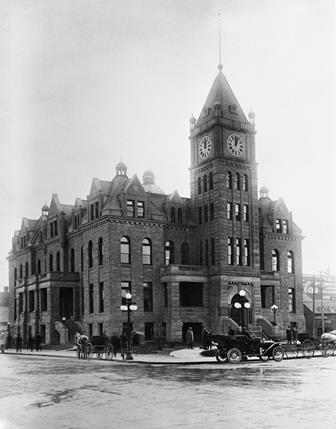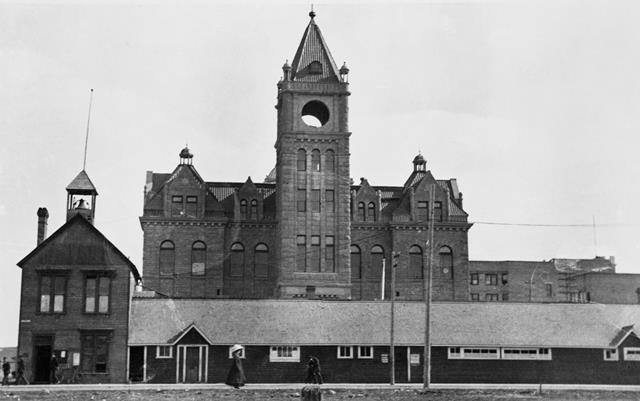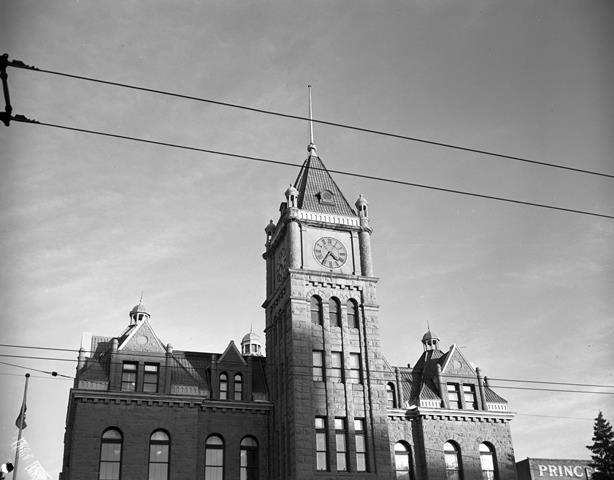City Hall’s Famous Clock
When Calgary first became a municipality in 1884 it was without a town clock and the new council’s first duty was to coordinate timepieces across the community. This was accomplished by having retired North West Mounted Police officer James H. Walker (1848-1936) fire a cannon every day at noon, to alert Calgarians of the time. As only the more fortunate citizens would have carried their own timepieces during this period, when plans were drawn up for a new City Hall in 1907, the inclusion of a public timepiece was an important consideration.
Architect William M. Dodd (1872-1949) envisioned a five-storey sandstone tower with an illuminated clock as the centerpiece of his City Hall design. During the first year of the building’s construction, however, costs mounted well above initial projections, and plans for the tower were nearly abandoned. In April 1909, the City proposed a bylaw for additional funds, but ratepayers voted it down. A public scandal ensued, during which the contractor walked off the job and architect Dodd was fired. For nearly a year, City Hall stood unfinished and virtually abandoned.
Calgarians eventually approved the funds to complete City Hall and construction resumed in the spring of 1910. Later that year, local jewellery firm D.E. Black was contracted to install the tower clock and, with the exception of winding, to provide maintenance for five years. He chose the latest model (#16A) made by the Seth Thomas Clock Company, which allegedly had "tower clocks in every city of any size in the United States or Canada," and which supplied the Canadian Pacific Railway (CPR) with its timepieces. Designed to strike the hours and half-hours, the four-faced clock was fitted with a 1,500 pound bell and was guaranteed to run within a variation of ten seconds per month, with proper care. Calgary's new City Hall opened for business on January 2, 1911 and four days later, the "mammoth" timepiece arrived in Calgary. It was Black's employee, Rudolph Engle (circa 1876-1912), who installed the clock.
The new City Hall tower clock was soon synched with the more "official" CPR time and it ran smoothly for the next several decades with little more than a weekly half-hour winding. In May 1955, however, the clock stopped short. It had deteriorated to the point that Mayor Donald H. Mackay (1914-1979) could not justify the cost of repairs. The sandstone tower itself was in such poor condition that the proposed course of action was to remove the clock and dismantle the top twenty feet of the tower. Fortunately, council approved repairs to the masonry instead, and the clock tower was retained.
By its sixty-ninth birthday in 1979, the Seth Thomas clock was running slightly ahead of time, gaining five minutes each month. It had been operating almost continuously since its installation in 1911, and it was beginning to decline. Owing to rotting bolts and gnarled gears, there was a serious risk that the clock's huge metal weights could give way at any moment. The clock's second major repairs were undertaken in the spring of 1984 and, after three months and hundreds of hours of maintenance, the gleaming clock was ticking once again. Further repairs were done in 1995 when the tower clock briefly stopped and again in November 2010 for life cycle repairs to the fly shaft.
As a reminder of the many hands responsible for maintaining the clock over the years, the clock room is inscribed with names and initials stretching back to 1912. Calgarians now carry an array of digital watches and mobile phones, and the tower itself, which once dominated the landscape of Calgary’s downtown core, has become overshadowed by the office blocks that reflect the city’s phenomenal growth since 1911; still the huge four-faced clock remains a well-loved public timepiece and landmark, and the very symbol of Calgary’s municipal administration.




